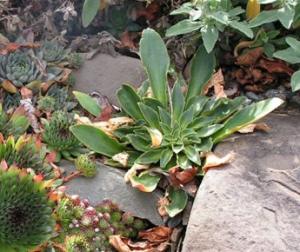Companion plant for troughs and rockeries
Lewisia is one of those highly underutilized alpine plants, mostly because of its knack of dying out in a couple of years when planted in the wrong spot.

It requires excellent drainage in a rich gritty soil, originating as it does in the high mountains in North America, but it also needs frequent water and a cool root run.

Planting in trough gardens, hypertufa containers and rockeries will supply these needs quite well. In fact, Lewisia has experienced a revival in interest due to the parallel interest in trough gardening and making hypertufa projects.
Easily grown from seed, although slow to reach the size needed for transplanting into larger containers or its final display area, Lewisia once established can be eye catching in bloom. The large individual six petalled flowers in peach, pink or white are held high above the foliage in a spray, lasting for several weeks.
Unfortunately, once the flowering season is over, Lewisia tends to be forgotten, as just a clump of green leaves in a rosette. An exception to this trait is Lewisii ‘George Henry’, which will bloom from May until the autumn.
The foliage of most Lewisia is attractive enough; usually grey or blue green, spoon shaped leaves emerging from a central point stay fresh all season. Typically, there is a down curving point on the outer edge of the leaves.
Many hybrids have arisen from the species once common in rock gardens of collectors. Some species which have been used to hybridize are also still around in their original form such as L. columbiana, L. cotyledon, L. finchae, L. heckneri, L. howellii, l. mariana and L. purdyi. Many others have inter married and formed some of the most beautiful hybrids such as Lewisia ‘Pinkie’, short little dwarf plants with lots of narrow petalled pink flowers.

Other species such as L. tweedyi have never been hybridized. Many different forms are available with flowers in shades of apricot, yellow and pink and some types are seen with deep rose red and even white albino flowers.
After blooming, Lewisia should be allowed to dry a little to rest. Some species such as L. nevadensis and L.oppositifolia are summer dormant, losing their leaves and disappearing. I suspect that a lot of these plants are summarily pulled up when the novice grower thinks they are dead. If left, they will re-emerge to bloom again the following season.
Lewisias ideal conditions are in a crevice garden or planted on a slope, where they can obtain the perfect drainage they require. If you have a knack with challenging plants that require a certain benign neglect, these may just be the plants for you to try and grow with seed propagation.

